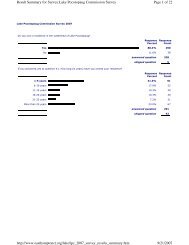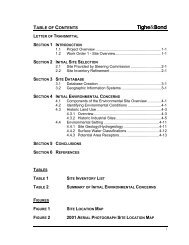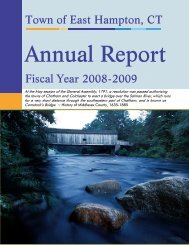Lake Pocotopaug Lake and Watershed Restoration Evaluation ...
Lake Pocotopaug Lake and Watershed Restoration Evaluation ...
Lake Pocotopaug Lake and Watershed Restoration Evaluation ...
Create successful ePaper yourself
Turn your PDF publications into a flip-book with our unique Google optimized e-Paper software.
Completeness is a measure of the amount of valid data obtained from a measurement systemcompared to the amount that was expected to be obtained under normal conditions (defined asthe conditions expected if the sampling plan was implemented as planned). Completeness iscalculated as( number of valid measurements)Completene ss =x100( number of measurements planned)<strong>and</strong> was 100% for in-lake samples. Stormwater sampling was variable. A total of 46 samplerswere set to capture first flush stormwater. Of the 46, 35 filled <strong>and</strong> were analyzed, resulting in76% completeness. Samplers either did not fill enough or were washed away due to heavyflow.Representativeness expresses the degree to which data accurately <strong>and</strong> precisely represent acharacteristic of a parameter, process, population, or environmental condition within a definedspatial <strong>and</strong>/or temporal boundary. Following the study design <strong>and</strong> applying the proper samplingtechniques <strong>and</strong> analytical testing maximized representativeness of the data collected. Wherechoices of stations to be sampled were made, effort was expended to ensure that those sitessampled were most representative of the conditions the study intended to assess.4.2 HydrologyHydrological data for <strong>Lake</strong> <strong>Pocotopaug</strong> included water inputs from tributaries, groundwater,direct precipitation, <strong>and</strong> runoff from the watershed. The hydrology was linked to water qualitydata to evaluate pollutant loads. General runoff from the watershed <strong>and</strong> incoming water fromthe tributaries were estimated from a combination of actual flow data <strong>and</strong> yields frommathematical models based on watershed characteristics. Direct precipitation on <strong>Lake</strong><strong>Pocotopaug</strong> was calculated as the average precipitation (1994-2001 = 124.4 cm) times the lakesurface area. Precipitation data were obtained from East Hampton/Colchester Water PollutionControl Plant <strong>and</strong> the Weather Underground web site. Ground water balance was estimated by:1. using stormwater flow rate from the Environmental Protection Agency Rational Method(Q=CIA, where C=slope (0.05), I=rainfall intensity (1”/hr), <strong>and</strong> A=surface area (200 ac)),<strong>and</strong>2. using a rate of 20 liters/m 2 /day multiplied by area assumed to contribute direct groundwaterflow (200 ac).Information for physical characteristics of <strong>Lake</strong> <strong>Pocotopaug</strong> <strong>and</strong> its watershed were gatheredfrom the following:Topography – United States Geological Survey (USGS) 7.5 minute topographic maps atMAGIC University of Connecticut Geographic Information Center web site<strong>Watershed</strong> Delineation – Field investigations, previous reports, <strong>and</strong> United StatesGeological Survey (USGS) 7.5 minute topographic mapsL<strong>and</strong> Use – CT DEP at MAGIC UCONN Geographic Information Center web site<strong>Lake</strong> <strong>Pocotopaug</strong> <strong>Restoration</strong> <strong>Evaluation</strong> 19May 2002







